Data Centers That Are Sustainable: The Campaign for Environmentally Friendly Cloud Computing

Data Centers That Are Sustainable: The Campaign for Environmentally Friendly Cloud Computing
The Increasing Energy Demands of Data Centers
The digital age would not be possible without data centers, which provide the power that makes cloud services, streaming platforms, and apps for businesses function. On the other hand, they use a significant quantity of power, which is often comparable to the amount of energy required to meet the demands of a small metropolis. As Internet use increases throughout the world and cloud infrastructures develop, the need for data storage and processing continues to grow, which raises pressing worries about the effect on the environment.
The Importance of Green Cloud Computing
Sustainability in technology is no longer something that can be considered optional; it is an absolute must. The environmental impact of data centers has been subjected to increased scrutiny as corporations and governments have been working to achieve net-zero targets. The primary objectives of green cloud computing are to reduce carbon emissions, minimize energy consumption, and encourage the effective use of resources. The goal is to ensure that digital expansion does not come at the price of the world.
Energy efficiency as a primary concern
Employing hardware and systems that are energy efficient is one of the most straightforward methods for constructing data centers that are sustainable. As of late, when it comes to the design of modern CPUs, storage devices, and networking equipment, power optimization is a primary concern. Additionally, cooling systems, which have historically accounted for a major proportion of the energy consumption of data centers, are undergoing redesigns in order to decrease waste.
The Integration of Renewable Energy Sources
A great number of data centers are making the transition away from fossil fuels and are beginning to make use of renewable energy sources including wind, solar, and hydroelectric electricity. The reduction of carbon footprints and the reduction of reliance on conventional grids are both being facilitated by the use of on-site renewable installations and long-term power purchase agreements (PPAs) with sources of clean energy.
Liquid cooling and state-of-the-art thermal management
Liquid cooling solutions, which have the ability to absorb heat more effectively and minimize the amount of energy that is wasted, are being used to replace traditional air-based cooling systems. As a method of maintaining high-performance systems while simultaneously reducing energy expenses, immersion cooling, in which servers are immersed in liquid that does not carry electricity, is becoming more popular.
Edge and modular data centers are two types of data centers that are distinguished by their design and functionality.
Furthermore, the movement toward edge data centers and modular data centers is beneficial for sustainability. The need for large-scale, centralized facilities is diminished by the presence of smaller, localized centers. This in turn reduces the loss of transmission and improves overall efficiency. These configurations are very beneficial for powering Internet of Things (IoT) networks as well as low-latency applications.
Intelligent Energy Management Through the Use of Artificial Intelligence
Artificial intelligence is assuming an increasingly important role in the optimization of data center operations. Systems that are powered by artificial intelligence (AI) have the ability to make adjustments to cooling, power distribution, and task balancing in real time. These systems can ensure that resources are used only when and where they are required. The expenditures are reduced, and the environmental effect is lessened as a result of this automation.
Methods of the Circular Economy
In addition, sustainable data centers are concerned with the whole life cycle of equipment. Electronic waste is reduced when hardware is recycled, refurbished, and reused. In an effort to increase the amount of time that components may be used before they have to be replaced, businesses are beginning to use circular economy models. At the same time, they are developing systems that will be simpler to disassemble and recycle as soon as the components reach the end of their usable lifetime.
Standards and Regulations
Governments and international groups are advocating for more stringent sustainability criteria in technological infrastructure. Companies are being encouraged to make investments in more environmentally friendly solutions as a result of regulations that pertain to carbon reporting, the use of renewable energy, and standards for energy efficiency. In addition to lessening the effect on the environment, adhering to these criteria also improves the reputation of the company.
Benefits for Business and the Economy
In addition to being an environmentally responsible thing to do, being green also makes good economic sense. Data centers that are energy efficient minimize operating expenses, decrease dependency on energy markets that are subject to change, and are appealing to customers who are concerned about sustainability. These days, companies that make use of environmentally friendly cloud solutions are becoming more and more seen as being socially responsible and forward-thinking.
Difficulties That Must Be Overcome
There are still obstacles that must be overcome, even if some progress has been made. The adoption of renewable energy sources may be slowed down by the high upfront costs of integrating them, the restricted availability of sustainable infrastructure in certain areas, and the need for continuous advancements in technology. Nevertheless, the expectation is that these obstacles will become less of a problem as the need for more environmentally friendly alternatives continues to increase.
How to Pave the Way for a More Environmentally Friendly Digital Future
It is anticipated that by the year 2030, data centers that are environmentally sustainable will be the standard in the business, as opposed to being the exception. Green cloud computing will become both viable and economical thanks to advancements in renewable energy, cooling technologies, and artificial intelligence-powered efficiency. The digital world will continue to grow, but it will do so with less of an effect on the environment.
When it comes to making digital innovation compatible with environmental responsibility, sustainable data centers are an essential step in the right direction. The cloud may expand without leaving a significant carbon footprint behind if it employs renewable energy, cutting-edge cooling techniques, artificial intelligence optimization, and circular economy principles. The movement to promote green cloud computing is not only a passing fad; it is the cornerstone of a future in which sustainability and technology advance in tandem.




